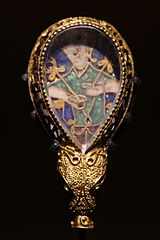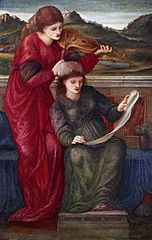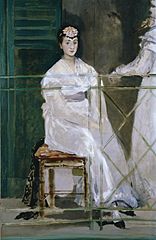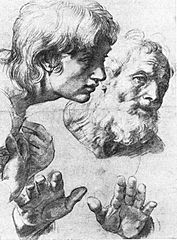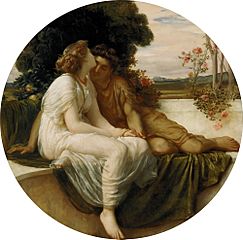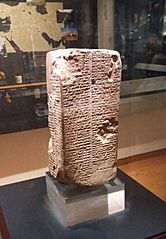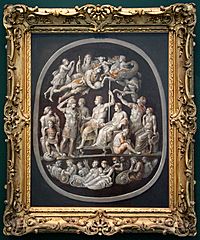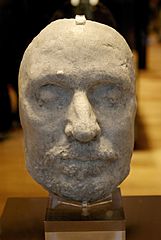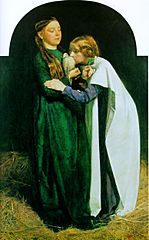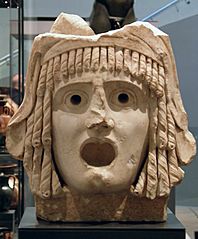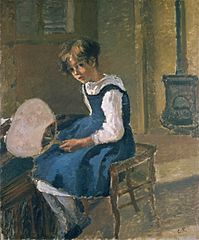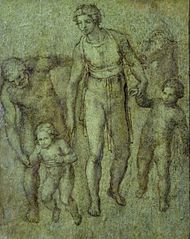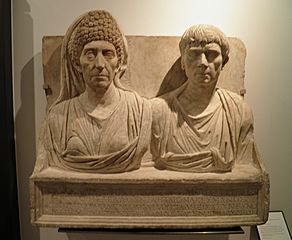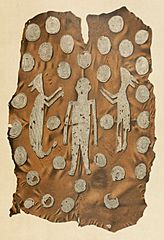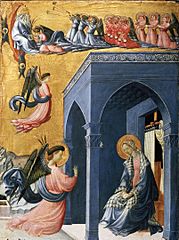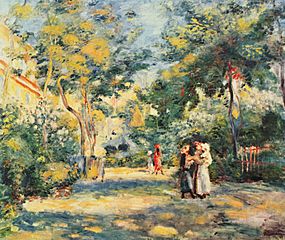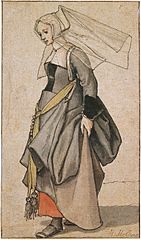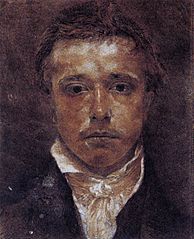Ashmolean Museum facts for kids

Front façade of the museum
|
|
| Lua error in Module:Location_map at line 420: attempt to index field 'wikibase' (a nil value). | |
| Established | 1683 |
|---|---|
| Location | Beaumont Street, Oxford, England |
| Type | University Museum of Art and Archaeology |
| Visitors | 930,669 (2019) |
The Ashmolean Museum in Oxford, England, is a very old and important museum. It was the first public museum in Britain! It opened way back in 1683.
The museum started when Elias Ashmole gave his amazing collection of interesting objects to the University of Oxford in 1677. This collection was like a "cabinet of curiosities," full of rare and unusual things.
The building you see today was built much later, between 1841 and 1845. The museum had a big makeover and reopened in 2009. New sections about Egypt and Nubia opened in 2011, and galleries showing art from the 1800s were updated in 2016.
Contents
The Museum's Story
The First Home on Broad Street
The Ashmolean Museum first opened its doors on May 24, 1683. A scientist named Robert Plot was its first leader. The original building on Broad Street is now called the Old Ashmolean.
The museum's first collection came from John Tradescant the Elder and his son, John Tradescant the Younger. They were gardeners and explorers who collected many strange and wonderful things. Their collection included old coins, books, drawings, rocks, and animal specimens. One famous item was the stuffed body of the last dodo ever seen in Europe! Sadly, by 1755, the dodo was so old and eaten by moths that only its head and one claw were saved.
Moving to Beaumont Street
The museum's current building was designed by Charles Robert Cockerell. It was built between 1841 and 1845 in a grand, classical style on Beaumont Street. Part of this building is also home to the Taylor Institution, which teaches modern languages at the university.
Arthur Evans became the museum's leader in 1884. He helped make the museum what it is today. He found that many of the original Ashmole collection items had been lost. A generous gift of £10,000 from Charles Drury Edward Fortnum helped Evans build an extension. In 1894, the Ashmole collection moved into this new part of the University Galleries.
In 1908, the Ashmolean and the University Galleries officially joined together to become the Ashmolean Museum of Art and Archaeology. The museum also became a place to keep important finds from Evans's digs in Crete.
After the old collection moved, the "Old Ashmolean" building on Broad Street was used for offices. Since 1924, it has been the Museum of the History of Science. It shows scientific tools, including the world's largest collection of astrolabes (old tools used to tell time and study stars).
Modern Updates and Changes
The inside of the Ashmolean Museum has been greatly updated in recent years. It now has a restaurant and a large gift shop.
In 2000, a special Chinese Picture Gallery opened. It was built inside an empty space in the old building. This gallery is the only museum gallery in Britain dedicated to Chinese paintings.
From 2006 to 2009, the museum had a huge expansion designed by architect Rick Mather. This project cost a lot of money but added two more floors, doubling the space for displays. It also created new areas for taking care of artworks and for educational programs. The updated museum reopened on November 7, 2009.
On November 26, 2011, the museum opened new galleries for Ancient Egypt and Nubia. This allowed many objects that had been stored away for years to finally be shown to the public. It meant more mummies and coffins could be seen!
In May 2016, the museum opened new galleries to show its collection of Victorian art. This included bringing back the "Great Bookcase," a very important piece of painted furniture from the Victorian age.
Amazing Collections
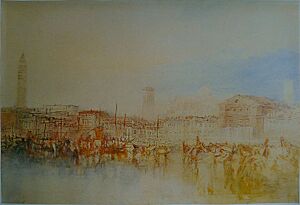
The Ashmolean Museum has huge collections of archaeological items and beautiful art. It has one of the best collections of Pre-Raphaelite paintings, fancy majolica pottery, and English silver.
The archaeology section includes many items from Arthur Evans's collection, like Greek and Minoan pottery. There's also a large collection of ancient objects from Ancient Egypt and the Sudan. The museum is also home to the Griffith Institute, which helps people study Egyptology.
Some of the most famous items you can see at the Ashmolean include:
- Drawings by famous artists like Michelangelo, Raphael, and Leonardo da Vinci.
- Paintings by Pablo Picasso, J. M. W. Turner, Paul Cézanne, and many others.
- The Alfred Jewel, a beautiful Anglo-Saxon piece of jewelry.
- The Messiah Stradivarius, a very special violin made by Antonio Stradivari.
- A collection of 96 still life paintings, including works by Clara Peeters.
- The Pissarro Family Archive, with paintings and letters from Camille Pissarro and his family.
- Ceremonial clothes that belonged to Lawrence of Arabia.
- A death mask of Oliver Cromwell.
- The Crondall hoard, a rare collection of Anglo-Saxon gold coins.
- Many ancient Oxyrhynchus Papyri, including parts of Old and New Testament biblical manuscripts.
- Over 30 pieces of Late Roman gold glass from the Catacombs of Rome.
- A collection of Posie rings (rings with short poems or messages).
- Many ancient items from Prehistoric Egypt and the early Egyptian kingdoms.
- The Parian Marble, an ancient Greek timeline.
- The Metrological Relief, which shows Ancient Greek measurements.
- The ceremonial cloak of Chief Powhatan.
- The lantern that Gunpowder Plot conspirator Guy Fawkes carried in 1605.
- The Minoan collection from Arthur Evans, the largest outside Crete.
- The Narmer Macehead and Scorpion Macehead, important ancient Egyptian artifacts.
- The Kish tablets and the Sumerian Kings List.
- A large collection of ancient Near Eastern tablets, mostly from digs in Kish, Iraq.
- The only remaining Pococke Kition inscription, which helped decode the Phoenician language.
- The Abingdon Sword, an Anglo-Saxon sword found near Abingdon.
- The Dalboki hoard of Thracian artifacts from Bulgaria.
- The Scythian antiquities from Nymphaeum, Crimea.
- The Shrine of Taharqa.
Collections Gallery
-
London Bridge on the Night of the Marriage of the Prince and Princess of Wales, 1864 by William Holman Hunt
-
The Brighton Pierrots, 1915, by Walter Sickert
-
The Alfred Jewel
-
Music, 1877, by Edward Burne-Jones
-
The "Two Dog Palette" from Hierakonpolis
-
Portrait of Mademoiselle Claus, by Édouard Manet
-
Studies of the Heads of two Apostles and of their Hands, by Raphael
-
The Hunt in the Forest by Paolo Uccello
-
The Forest Fire by Piero di Cosimo
-
Statue of Sobek, the crocodile god, from the pyramid temple of Amenemhat III
-
Acme and Septimius, around 1868, by Frederic Leighton, 1st Baron Leighton
-
The Sumerian Kings List, dating to approximately 1800 BC
-
The Apotheosis of Germanicus, a copy after an antique Cameo painted in 1626 by Peter Paul Rubens
-
A death mask of Oliver Cromwell
-
The Return of the Dove to the Ark, 1851, by Sir John Everett Millais
-
Jeanne Holding a Fan, an oil on canvas painting by Camille Pissarro, around 1874
-
The Holy Family with St John the Baptist, brush and brown wash on panel by Michelangelo
-
Portrait of John Ruskin by John Everett Millais
-
The Mantle of Chief Powhatan, dating to the 17th century
-
The Abingdon Sword, dating from the late 9th or early 10th century
-
The Annunciation, attributed to Paolo Uccello
-
Restaurant de la Sirène, Asnières, by Vincent van Gogh
-
A Garden in Montmartre by Pierre-Auguste Renoir
-
Young Englishwoman, a costume study by Hans Holbein the Younger
-
A self-portrait by Samuel Palmer
-
A coin of Domitianus II
-
Early Bronze Age Cycladic art figurine, 2800–2300 BC.
-
The Kish tablet cast
-
Guy Fawkes' Lantern, London, England around 1605 Iron and horn
-
The sole surviving Pococke Kition inscription, used by Jean-Jacques Barthélemy in his decipherment of the Phoenician language
The Arundel Marbles
Broadway Museum and Art Gallery
In 2013, a new museum opened in a 17th-century building called "Tudor House" in Broadway, Worcestershire. This museum works with the Ashmolean Museum. It became the Broadway Museum and Art Gallery in 2017. It displays paintings and furniture from the Ashmolean's first collections, along with local items that tell the story of the village.
Past Exhibitions
The Ashmolean Museum often hosts special exhibitions. Here are some that have happened in recent years:
- Labyrinth: Knossos, Myth and Reality: This exhibition explored the famous myth of the Minotaur and the real history of Knossos. It was open from February to July 2023.
- Pre-Raphaelites: Drawings & Watercolours: This show featured beautiful drawings and watercolors by the Pre-Raphaelite artists from the Ashmolean's own collection. It was shown in 2021 and again in 2022.
- Pissarro: Father of Impressionism: From February to June 2022, this exhibition showed artworks by Camille Pissarro, a key artist in the Impressionist movement.
- Tokyo: Art and Photography: This exhibition, open from July 2021 to January 2022, showed art from Tokyo, including old woodblock prints and modern photography.
- Young Rembrandt: From August to November 2020, this exhibition focused on the early works of the famous artist Rembrandt. It included over 120 of his paintings, drawings, and prints.
- Last Supper in Pompeii: This exhibition, from July 2019 to January 2020, explored what people ate and drank in the ancient Roman city of Pompeii. Many items had never left Italy before.
- Jeff Koons at the Ashmolean: From February to June 2019, this exhibition featured 17 major works by American artist Jeff Koons. His art was placed alongside historical pieces, creating interesting conversations.
- Spellbound: Magic, Ritual & Witchcraft: This exhibition, from August 2018 to January 2019, explored the history of magic over eight centuries. It showed 180 objects, from old charms to new artworks.
- America's Cool Modernism: O'Keeffe to Hopper: From March to July 2018, this exhibition showed works by American artists from the early 1900s. Many of these paintings had never been seen outside the US.
- Imagining the Divine: Art and the Rise of World Religions: This exhibition, from October 2017 to February 2018, looked at how art helped spread five major world religions.
- Raphael: The Drawings: From June to September 2017, this exhibition brought together over a hundred drawings by Raphael from around the world.
- Degas to Picasso: Creating Modernism in France: From February to May 2017, this exhibition told the story of how Modernism in art began, with works by artists like Matisse, Manet, and Picasso.
- Power and Protection: Islamic Art and the Supernatural: From October 2016 to January 2017, this exhibition explored how magic and protection were shown in Islamic art.
- Storms, War and Shipwrecks: Treasures from the Sicilian Seas: From June to September 2016, this exhibition showed discoveries from underwater archaeology in Sicily.
- Andy Warhol: Works from the Hall Collection: From February to May 2016, this exhibition featured over a hundred works by the famous Pop artist Andy Warhol.
- Drawing in Venice: Titian to Canaletto: From October 2015 to January 2016, this exhibition showed a hundred drawings from Venice, spanning three centuries.
- Great British Drawings: From March to August 2015, this exhibition displayed over a hundred British drawings and watercolors from the Ashmolean's collection.
- Discovering Tutankhamun: From July to November 2014, this special exhibition explored Howard Carter's discovery of Tutankhamun's tomb in 1922.
- Cézanne and the Modern: From March to June 2014, this exhibition showed Impressionist and Post-Impressionist paintings.
- Stradivarius: From June to August 2013, this exhibition explored the life and work of Antonio Stradivari. It was the first time 21 of his instruments were shown together in the UK.
- Master Drawings: From May to August 2013, this exhibition showed a selection of the Ashmolean's best drawings, including works by Leonardo, Michelangelo, and Raphael.
Museum Leaders
The museum has had many leaders over the years. They were first called "Keepers" and then "Directors."
| Name | From | To |
|---|---|---|
| Robert Plot | 1683 | 1690 |
| Edward Lhuyd | 1690 | 1709 |
| David Parry | 1709 | 1714 |
| John Whiteside | 1714 | 1729 |
| George Shepheard | 1730 | 1731 |
| Joseph Andrews | 1731 | 1732 |
| George Huddesford | 1732 | 1755 |
| William Huddesford | 1755 | 1772 |
| William Sheffield | 1772 | 1795 |
| William Lloyd | 1796 | 1815 |
| Thomas Dunbar | 1815 | 1822 |
| William Philipps | 1822 | 1823 |
| John Shute Duncan | 1823 | 1826 |
| Philip Bury Duncan | 1826 | 1854 |
| John Phillips | 1854 | 1870 |
| John Henry Parker | 1870 | 1884 |
| Sir Arthur Evans | 1884 | 1908 |
| David George Hogarth | 1909 | 1927 |
| Edward Thurlow Leeds | 1928 | 1945 |
| Sir Karl Parker | 1945 | 1962 |
| Robert W. Hamilton | 1962 | 1972 |
Since 1973, the main leader of the museum has been called the Director:
| Name | From | To |
|---|---|---|
| Sir David Piper | 1973 | 1985 |
| Professor Sir Christopher White | 1985 | 1997 |
| Roger Moorey (acting) | 1997 | 1998 |
| Christopher Brown | 1998 | 2014 |
| Alexander Sturgis | 2014 |
Important People at the Museum
Current Keepers
- Christopher Howgego, in charge of the Coin Room.
- Mallica Kumbera Landrus, in charge of Eastern Art.
- Liam McNamara, in charge of ancient objects (Antiquities).
- Jennifer Sliwka, in charge of Western Art.
Theft and Returns
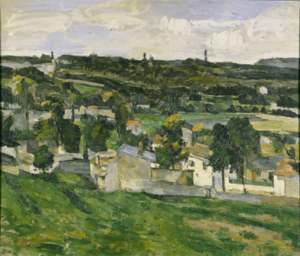
On New Year's Eve in 1999, during millennium celebrations, thieves broke into the museum. They stole a painting by Paul Cézanne called View of Auvers-sur-Oise. This painting was worth a lot of money. It was an important work showing how Cézanne's painting style changed. The painting has never been found.
In 2024, the museum agreed to return a 500-year-old bronze statue of a Hindu poet and saint. The statue was bought by the museum in 1967. However, the Indian High Commission said it had been stolen from a temple in India in 1957.
See also
 In Spanish: Museo Ashmolean para niños
In Spanish: Museo Ashmolean para niños







